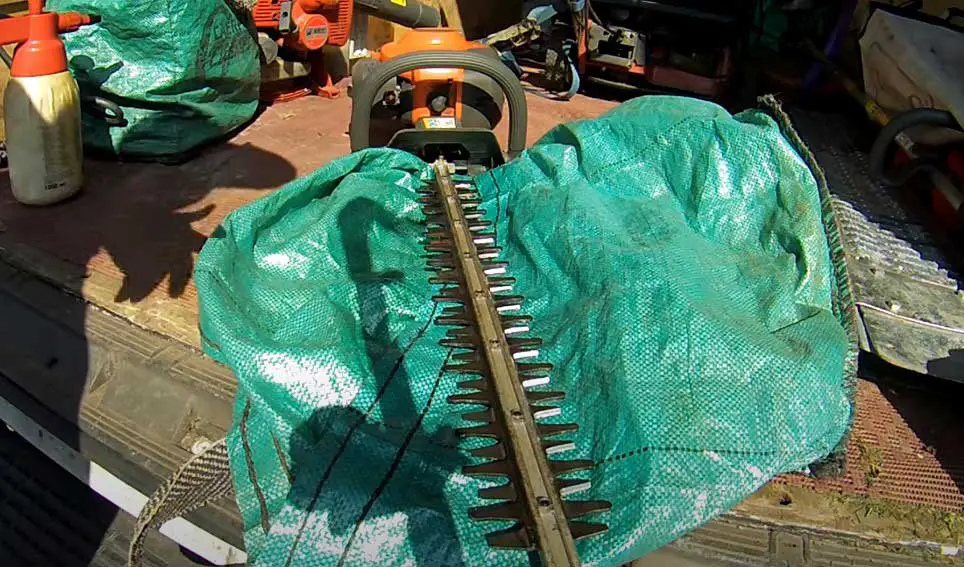The sun is shining, you have some free time, and the hedge is looking as if it’s taking over your garden. So, you decide to keep it in check with your trusty Stihl hedge trimmer.
But there’s a problem: you’re all set up and ready to go, you hit the power button, but the blades don’t budge! Something is clearly wrong. No matter how many times you switch it on and off, the hedge trimmer just won’t fire up. In some cases, the motor or engine runs, in other cases, it may be dead.
As well-made as these machines are, this sometimes happens. So, what’s happened and how do you fix it?
Join us as we go through the various possible causes and find out what steps to take to get your Stihl hedge trimmer blades working again.
First Things First: Be Safe!
Stihl produces petrol, battery and mains electric-powered hedge trimmers. Whichever model you have, you must make sure it is safely switched off before examining it, with no chance of it being accidentally powered up:
- For a petrol-driven model, remove the spark plug
- Remove the battery pack from a battery-powered model
- Unplug a mains electricity-powered hedge trimmer
Ensure that the power button is set to ‘off’.
Also, be prepared by having some of these items to hand:
- Screwdriver
- WD40 or another appropriate lubricant including multi-purpose grease
- Flat file
- Safety gloves
- Wooden dowel
- Resin solvent
- Steel wool pad
- Allen keys
- Paper towels or a soft cloth
- Whetstone
- Sandpaper
Common Reasons For Hedge Trimmer Blades Not Moving
Now that you’ve made the machine safe, it’s time to check what’s causing the problem.
There are several reasons for this, so we’ll go through them one by one, starting with the most common issue.
The Trimmer Blades Are Jammed With Debris
This is probably the number one cause! After being used several times the blades start to loosen and move away from each other slightly, allowing debris to become stuck between them.
Lay the trimmer on a flat surface and check the blades carefully to see if there are twigs or leaves caught between them. Carefully remove any debris by hand, or use a piece of wooden dowel for any stubborn bits. Don’t use anything metal as this can damage the blades.
Wipe the blades down with a damp cloth and then apply a light coat of oil to lubricate them.
Damaged Blades
It’s possible that hedge trimmer blades can become damaged, especially with prolonged heavy use. Bent or broken blades can stop a hedge trimmer from working, and they can also be dangerous.
However, a good-quality machine is unlikely to become damaged without you knowing about it. Maybe it was dropped, or perhaps it snagged a hidden obstacle inside a hedge (metal, concrete or wooden fence posts and chain-link fences are major culprits). Also, it’s possible that the hedge trimmer was used to tackle something too big, like tree branches.
Firstly, this last one is a very bad idea. It’s called a hedge trimmer for a reason! For anything thicker than this, always use the appropriate tools. Secondly, it’s a good idea to check for any obstacles before any hedge-cutting projects, as far as practical.
Whatever the cause of your damaged blade, it’s essential that it is fixed.
If a hedge trimmer blade has slightly bent teeth, it’s possible to bend them back into shape using pliers or a hammer. You’ll need to remove the blade assembly to do this (wearing safety gloves), along with any bolts holding the blades in place. Keep any screws or bolts safely to one side and remember which order they go back.
Once you’ve removed the blade, set it down on a solid flat surface and tap the bent tooth gently with a hammer. Alternatively, used pliers to bend it back into shape. Take great care not to overdo it, or you may snap the blade!
This only works if the bend is not too bad. Severely bent blades should always be replaced as they will be weakened and may break during use.
Rusty Blades
If you’ve not used your hedge trimmer for months, there’s a chance that the blades have rusted.
And if the rust is thick enough, it may prevent the blades from moving back and forth.
To resolve this, remove each hedge trimmer blade and use a steel wool pad to loosen the rust, then go over them again with coarse-grit sandpaper, followed by fine sandpaper to remove any scratches.
If you wish, you could use a handheld rotary tool and sanding disc for this job.
Wipe the blades with a damp cloth, dry them off well and lubricate them with oil. Also, it’s best to store hedge trimmers in a dry place that’s unlikely to get damp or condensation while you’re not using them.
Clutch Issues
A broken clutch will certainly stop your hedge trimmer from working!
If your hedge trimmer motor or engine runs but the blades don’t move, this is one possible answer.
Of course, it may not be actually broken, but it could be improperly tensioned.
If it is a broken clutch, you’ll need to replace this to get the trimmer going again. If it’s a tension problem, you may be able to resolve this yourself as the instruction manual will show you how to do this. Alternatively, you can find a local garden centre or garden equipment repair centre to do this for you.
Worn Out Gearbox
The gearbox converts the motion of the engine or motor, via the cam shaft, into the oscillating movement that makes the blades slide against each other.
Worn out or stripped gears can stop hedge trimmers from operating. While it’s not likely to happen for some time, this can occur after several years of use due to general wear and tear. When you dismantle the trimmer, you may find that the bearings are floating around inside the mechanism as they have disintegrated.
If this does happen, you may need to replace the gearbox completely, but always double-check that you have the correct part or you risk further damage to the trimmer. It may also be possible to replace some of the small parts, but this is a tricky and intricate job, so be prepared!
If you’re lucky, it may be that some debris has made its way inside the casing and is blocking the cam, or that your machine desperately needs lubrication. You’ll usually know that this is the problem as you will notice unusual vibration and juddering while using the trimmers.
Remove the gear case using allen keys. Get rid of any old grease, dirt, twigs or leaves you find and brush out the casing before lubricating the gears well.
Damaged Gear Case
The gear case protects the gears from damage and keeps everything in place. It also forms a safety barrier between you and the moving parts and stops
As you can see, it’s an essential part! And if this gets damaged it puts pressure on the mechanism inside, which can affect the operation, stopping the cam from sending power to the blades.
Any damage should be obvious, although you’ll need to remove the case to check if the gasket is intact.
Replace any parts that are damaged, and your hedge trimmer should function as normal.
Sap And Resin Build-Up
Depending on the variety of hedges you have, it’s possible for the hedge trimmer’s blades to become gunked up with resin or sap.
Solvent resin removers are widely available and these can be used to clean up the blades.
It’s best to remove them completely to do this job, just to make sure you are getting rid of all the gunk.
Give them a good wipe down afterwards and make sure they are well lubricated before fixing them back in place.
Dead Spark Plug
It’s possible that your petrol hedge trimmer has a dead or cracked spark plug. You’ll spot if this is the case as soon as you see it: the insulator may be broken and the electrode covered in carbon or showing signs of severe burning.
It’s fairly easy to replace the spark plug, and you’ll have it up and running again.
Dirty Carburettor
Although not a common issue in relation to hedge trimmer blades not moving, it can still be a cause. This problem is more likely to result in a petrol-driven toll that idles okay, but stalls when you open the throttle.
It’s usually caused by leaving fuel in the hedge trimmer for a long time without using it.
The good news is that the carburettor can be flushed out pretty easily, although it sometimes needs replacing completely to fix the problem.
Electric Hedge Trimmer Problems
It has to be said that these are more of an issue, in the sense that they aren’t as easy to fix at home as battery or petrol-driven models.
First, look for any obvious causes, like damaged blades or debris caught in between them.
Aside from checking whether the power cable is damaged or that the fuse is good, it’s often best to leave any investigations and repairs to an expert.
In Conclusion
One of the best ways to avoid any of the above problems is through proper maintenance and care of your Stihl hedge trimmer. You can find out more, and lengthen the life of your power tool using the Stihl fix app for Android devices.
Sharp blades are essential, so you should sharpen the teeth after every fifty hours of use. You can take your hedge trimmer to a local garden centre or lawn mower shop that offers a sharpening service. Alternatively, use a flat file to do this job yourself, always pointing the file towards the tip of the trimmer blade, then go over the teeth with a whetstone to remove any metal burrs.
Always use a harness and never overreach while using a hedge trimmer as you may drop it, possibly resulting in bent teeth – not to mention the potential damage to yourself.
Finally, always clean down your tool after any trimming job. Give it a good wipe over and liberally spray WD40 on the blades to limit the risk of rust. This will also keep them in good working order for the next time you use them. If you don’t plan to use your petrol hedge trimmer for some considerable time (say, over winter), it’s a good idea to drain the fuel beforehand.
A Stihl hedge trimmer is an excellent piece of equipment and will last for years if handled correctly and given proper maintenance.


